Best Sound Design VST Plugins
For me, this blog category is the most interesting one as I’m always looking for new, creative ways to produce unique Sample Packs. Therefore hundreds of VST Plugins are installed on my audio system and the number is constantly increasing – crazy I know 😉 But even after more than 30 years of sound design, I still love to experiment and venture into new sonic worlds. Simply put, changing a sound into something completely new is one of my biggest joys. This is my current list (updated regularly) of the Best Sound Design VST Plugins. For detailed specifications please visit the linked websites of the manufacturers.
Forever 89 – Visco
Svante Stadler and Rikard Jönsson recently founded Forever 89 and released the sample-modeling drum machine Visco as their first product. And what can I say – this is really an innovative and inspiring method of doing hands-on sound design.
Visco lets you work with drum samples (not only!) like a synth plugin, so you can morph between various samples and alter them using a graphical user interface that looks incredibly fascinating and user-friendly.
It’s central feature is the blob, a flexible 2D grid representation of your sound. You have total control over how you use the crossfader, hand, eraser tool, and other tools that resemble those in contemporary UI design software to grasp, pull, push, and blend your sound.
Indeed you can blend the characteristics of two sounds into one!

How does it work? Your own samples are loaded and examined, and an approximate version of the original sound is produced; the original is then discarded. A few details are missing, so it doesn’t sound 1:1, but I’m sure that updates will gradually lessen the sample deviations. Please don’t get me wrong, even in this early version, this is already an impressive replica.
Here are some additional specifications: global and per-part controls for transform, timescale, frequency, contrast, and density; an 8-part, 32-voice drum engine. Additionally, there is an 8-track sequencer with drag-and-drop note event and length dragging, swing, and time/velocity variations. Numerous options and an assignable grid are present on the modulation page. Pan, stereo width, two sends, clipping distortion, per-track filter, and mixer In addition, send and master effects such as tape simulator, transformer amp, tempo delay, chorus, diffusers, reverbs (plate, room, spring), stereo fuzz, and various compressors (including upward) are used. You see – lots to explore!
Some experimental features allow you to quickly create new sounds by flipping your samples both vertically and horizontally. Smudging or pulling the blob yields more experimental results that are ideal for sound design.
An application example: You occupy the snare slot with 2 snares. To do this, move the slider at the top to the left and drag & drop the “normal sounding snare”, then move the slider to the right and add e.g. a massive, huge, and powerful snare. Then, you have a choice between two snares. The seamless morphing feature is amazing because it goes beyond simply layering your two snares and adjusting the volume of each layer. You really can blend the timbres of any two sounds. A lot happens here under the hood! For me, the morph slider is the most incredible feature of Visco!
Especially when it comes to automation options, the whole morphing thing is even better. Just think of a huge drop in your music and morph between a simple and complex sound – perfect for the tension. It gets more exciting when you not only import drums but also synth sounds, vocals, etc. There are no limits to your imagination.
Since the whole thing can sound very organic due to the modulations, e.g. very busy drum loops are possible, which can be added to static loops to breathe life into them or give your mix an organic feel.
On the left side of the grid, some bizarre features allow you to mirror the sound or blob. For instance, you can make a shaker-like sound out of a deep percussion sound. It’s difficult to put into words; you really must hear it. There are intriguing modifiers for each of the eight slots on the right (Timescale, Frequency, Contrast, etc.). The bottom buttons control all of the channels simultaneously, and the bottom left of the screen provides a brief explanation of what each one does. For an update, I wish I had a sequencer with 36 steps. By the way, Visco has an unlimited free demo, so there is no reason not to install this unique tool!
In my opinion, it’s the Synplant2 of drum machines, and it has some similarities to the Zynaptiq Morph. With Visco, samples can be altered in ways that were previously impractical. It really intrigues me a lot. A Swiss knife for sound design and strongly advised!
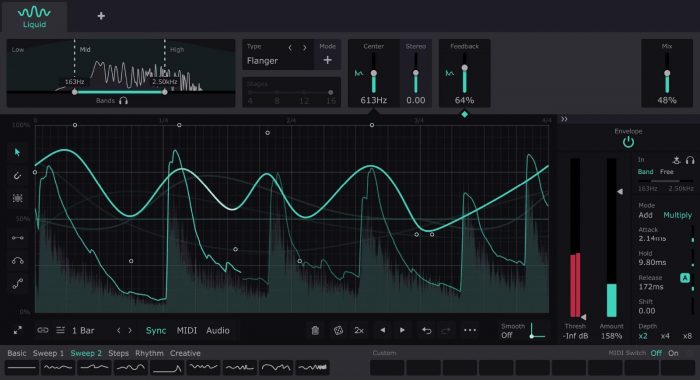
Cableguys Shaper Box3
The brand new ShaperBox 3 is a slick multi-effect toolbox with an easy-to-use interface. It combines now 9 different great-sounding effects (Time, Drive, Noise, Filter, Liquid, Crush, Pan, Volume, and Width). You can modulate them through a clever and well-designed intuitive GUI. In the new version, waveform editing is more intuitive than ever. You can also trigger all ShaperBox effects with any sound now. For instance, you could program your synth to start the drive effect each time a snare hits. Also, the reworked browser with its cleverly categorized 600 presets works great.
In Shaperbox 3 there is literally an unlimited amount of combinations of effects you can get. It revived my entire sample library. Moreover, it’s a refreshing new way to change the way I normally produce loops. The possibility of using audio as an internal trigger opens up great possibilities. The envelope follower’s multi-band properties also allow the use of external side-chaining and internal filters.
I like the fact that this plugin often leads to completely unpredictable and unique sounds. You can easily create wild, audio-mangling presets with a tremendous amount of fun. With ShaperBox, the focus is generally on rhythmic modulation using precisely modulatable LFOs, which also makes the plugin absolutely unique. Above all, the combination of several Shaper (or even several Shaperbox 3 at the same time) allows the sound to be extremely deformed beat-synchronously (if desired). What I think is great compared to the competition: Others work a lot with reverb and delay. This reduces the transparency and assertiveness of the signal. Shaperbox does not contain any modules that blur the signal. The results are always direct and straightforward.
Such precise and sophisticated rhythmic sound manipulations can hardly be created in such a short time with any other plugin. It’s definitely one of my favorite Plugins when it comes to sound design. Highly recommended!
Fabfilter Volcano 3
With Volcano 3, Fabfilter presents another major update to their fantastic filter plugin.
The new scalable GUI gives another dimension to this swiss knife. The workflow has been improved and the modulation section is now drag-and-drop editable with its eye-catching overview of all active modulations. I adore the modulation concept and how simple it is to get things going.
The filters that can add great color/character are the beating heart of Volcano 3 which never ceases to amaze me!
Volcano 3 has been outfitted with a further four analogue modeled non-linear vintage EQ filter shapes (including Bell, Low/High-Shelf, Notch,

All-Pass, and 6dB/Octave option), each with a Drive/Saturation control has, which allows a detailed intervention on the sound. Furthermore, you can now adjust the volume and panorama of each filter or choose between stereo and mid/side. For the best possible results, a high-quality mode for maximum oversampling was also integrated. Last but not least the presets are also unbeatable and impressively show what is possible here.
Volcano 3 is so much more than just a filter plugin. It’s also an ingenious sound design tool. What a beast!
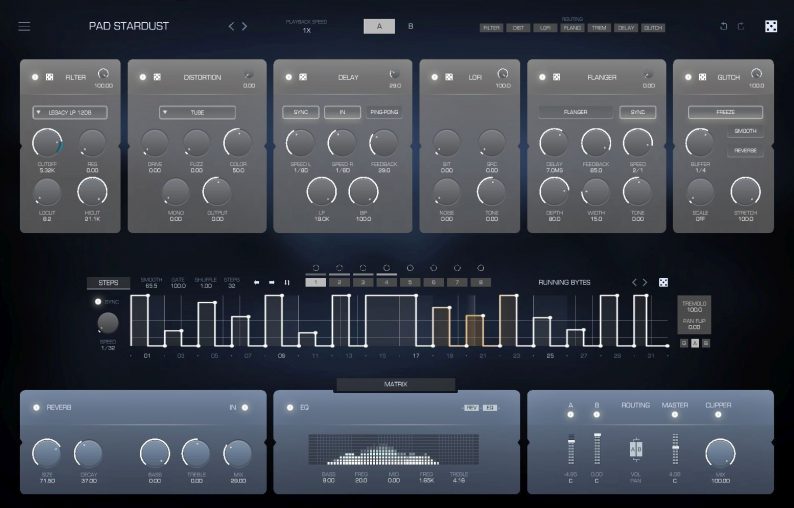
DS Audio Tantra 2
As a long-time and enthusiastic user of Tantra 1, I was extremely excited about the successor. Tantra 2 didn’t disappoint.
It’s a rhythmic multi-effects plug-in that can generate fascinating rhythmic sequences from any source material in a very intuitive way. With this, breathtaking results can be achieved with just a few clicks from even the simplest sounds.
Filter, Distortion, Delay, Lo-Fi, Flanger, and Glitch are six two-stage effects that can be used in any order. Each effect has two stages that can be run in either series or parallel.
The Modulator Section is the beating heart of the system.
Use complex 32-step envelopes with configurable form and multiple operating modes to build unique rhythmic patterns. Impulse responses from damaged microphones, ancient speakers, and other specific equipment are included in the Convolution section. The “intelligent” randomizer algorithm, which generates fresh custom settings on the fly, is one of my favorites.
With its very clean design and great new modern GUI, this tool has been improved in many areas and is in my opinion even more intuitive to use than the first version. While with V1 you sometimes had to lower the hard attacks with a Transient Designer, the results are far more pleasant with the successor. This amazing plugin brings me far closer to my creative vision and even shocks me with effect combinations I didn’t realize I needed until I heard them. Tantra 2 is an excellent sound design and creative mixing plugin, which I suggest for all kinds of electronic music.
Devious Machines Infiltrator
This sequenced multi-FX tool seems to be my new “secret weapon”. Infiltrator lets you stack and combine up to ten effects at the same time which you can fill with 28 effects. Combine them with complex modulation and sequencing capabilities.
You can choose between 12 different high-pass, low-pass and band-pass filters (e.g. modelled from SH-101 and MS20), formant, and comb filters. The sound of the filters is just impressive! There are also frequency shifter, ring modulator, FM, phaser, pitch shifter, looper, delay, reverbs, and overdrive. One wish: A reverse effect for the next update would be amazing.
The heart of the system, however, is the step sequencer with its 32 steps that make your effects come alive.
Devious Machines have thought of almost everything and

added a few more nifty details. With the immense number of 750 breathtaking presets, everyone will find a good starting point for their creations. The layout is clear and logical, easy to learn without using a manual. I like the fact that this plugin often leads to completely unpredictable and unique sounds. I think Infiltrator will replace some multi-FX plugins out there. One Plugin to rule them all!
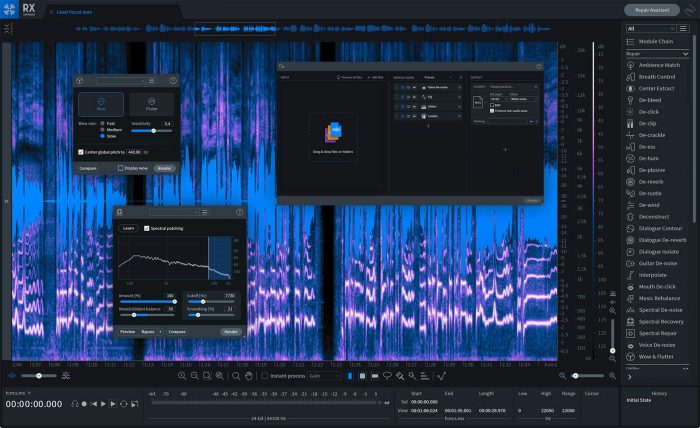
iZotope RX8 Advanced
iZotope RX8 Advanced is a great tool when it comes to ridding problematic recordings of unwanted background noise. There are many sophisticated modules available that impressively remove hum, clipping, clicking and even isolating dialogue from other noises.
Here are a few examples from my practice: “Dialogue Isolate” removes road or wind noise from field recordings without any problems. De-reverb as the name suggests removes reverb. This way, you can effortlessly bring the core of the recording “forward” in the mix again. Or if, for example, voice recordings were made with less than ideal equipment (or VoIP / telephone recordings), it is not
uncommon for highs to be missing in the frequency spectrum. A couple of clicks on “Spectral Recovery” solves the problem. You can’t achieve this with an Exciter/Vitalizer. Anyway, I think it’s impressive that you can really edit/remove everything that the spectrum display shows. This goes way beyond a normal EQ.
But it is not just about removing “disruptions/noise”. For instance, when I create a demo track, sometimes the mix of the different parts does not match 100%. But with “Music Rebalance” you can set the mixing ratios on the stereo sum at the end – yes, afterwards!
This tool is definitely a must-have for every mastering engineer or producer! Since you may be overwhelmed by the available modules at the beginning, the RX8 has a “repair wizard”. This diagnoses your audio data and offers processing suggestions. It’s that easy!
RX8 Advanced offers incredible possibilities when processing problematic audio material. It is impossible for me to go into all the features at this point. I am convinced that there is hardly anything comparable in this area – simply impressive.
Steinberg Backbone
I have been an enthusiastic Steinberg/Cubase user for well over two decades. Backbone has also fascinated me from the start.
This tool offers a new way of creating drum and hit sounds. You can decompose samples into tonal and noise elements and edit them separately from each other. Use re-synthesize to manipulate Samples completely free and flexible. The 8 slots invite you to creatively interconnect samples with their tonal & noise elements. Each slot can be changed intuitively with impressive options (re-synth, pitch, filter, amp, and useful effects).
The sound shaping possibilities are impressive. Its re-synthesis engine is easy to use. Since Blackbone uses only a small amount of CPU, you can easily load multiple instances and create a drum kit, for example.
In Version 1.1 the re-synth algorithm now takes the stereo correlation into account – great for

Stereo Samples. But the export options are also really well thought out (Drag & Drop). With Backbone Steinberg has succeeded in creating an innovative instrument. You can turn samples into something totally new. It’s one of the most powerful creative tools and is not only suitable for drum changes. Highly recommended.

iZotope Stutter Edit 2
I’ve been a big fan of Stutter Edit1 for a long time and always enjoyed using this tool for my sound design. With the 2nd version of this multi-effects glitch plug-in, you get a freely scalable and new user interface, fantastic sounding new effects and extended range of functions in many areas. For me, the most noticeable improvement is the new Time-Variant Modifier Curve (TVM curve). This means that almost every parameter has its own envelope – a real game-changer. You can trigger the tool (comes with 11 effect modules) via MIDI and the new easy to use Auto mode (I waited for this!). It’s easy to create complex rhythmic stutter and buffer effects.
Stutter Edit 2 is my favourite glitch plugin as it’s a creative, flexible toolbox and fun to use. While you can create truly unique, twisted and complex sounds in no time, you have incredible control over the result.
Stutter Edit 2 is a sound explosion, as it is sometimes hard to believe what Stutter Edit2 can conjure up from a normal sound. It’s one of the Best Sound Design VST Plugins. Highly recommended!
Fabfilter Saturn 2
Saturn 2 is an extremely flexible saturation/distortion plugin with options ranging from subtle, clean and warm saturation to total harmonic destruction.
V2 comes with a redesigned easy-to-use GUI (five UI sizes) with modulation visualization, 16 new distortion algorithms (28 in total), multi-band and side-chain operation, an adjustable slope for the crossovers, offering 6, 12, 24 and 48 dB/oct options, a new Transformer category, ergonomic improvements and more.
I have many distortion effects installed on my system. I believe Saturn covers natural-sounding and subtle distortion better than any other Plugin. From subtle, clean and warm tube or tape saturation to the wildest multiband guitar amp effects: FabFilter Saturn 2 delivers.
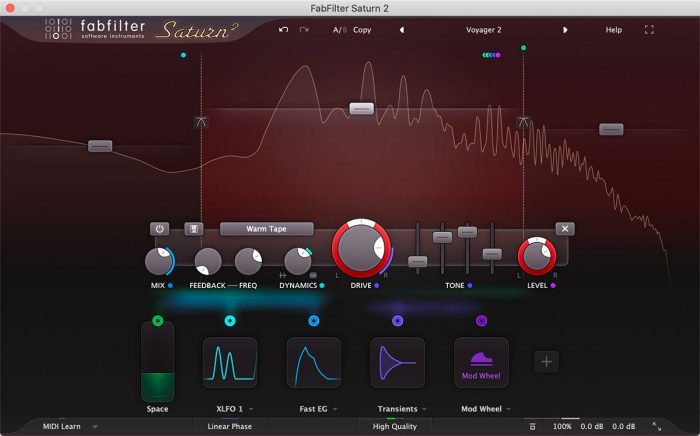
Saturn 2 with its easy-to-control user interface is varied and the substantial modulation possibilities are sonically outstanding! There are so many ways to tweak sounds! I like to use it on almost everything. The preset “Faster Master” is an insider tip! If you’re in search of a multiband distortion plugin for mixing & sound design, I can’t recommend Saturn 2 enough. FabFilter has delivered a winner in Saturn 2.

MeldaProduction Melda MXXX
Melda MXXX is the ultimate multi-effects software. This tool, in my opinion, can do anything you can think of.
It’s a modular beast that houses all Melda effects in a simple interface complete with an automatic routing matrix, super-versatile modulators, and more.
Melda MXXX allows you to perform everything from basic equalization and compression to the most bizarre and creative processing.
You can make up to 16 (multi) parameters accessible on the Easy page of MXXX to ensure easy handling of your effects chain despite the complexity of the plugin.
16 well-equipped modulators (LFO, volume/envelope/pitch follower, random) provide you with even more creative control over your sound.
It can function as a straightforward mastering suite, a powerful sound creation tool, or a more traditional, self-contained processing chain. There are over 70 top-quality processors and more than 500 presets are clearly presented in a browser with categories and favorites function.
There is also an online community that shares its work with MXXX. On almost every level of this Plugin, there are also useful Random buttons that produce interesting results.
MXXX is an intriguing modular effect monster that isn’t for beginners. If you are familiar with routing, though, you will soon see the plug-vast in’s creative potential. It is the most costly Multi FX plugin in this category, but it is also a sound designer’s best friend. Alternative: MXXXCore is a cost-effective approach to acquire MXXX, the ultimate effect. It’s inexpensive, and you can only purchase the modules you need.
Output Movement
This powerful multi-effect adds motion and rhythmic textures, uniqueness and interest to anything that passes through it in real-time. Movement breathes life into any track or live performance.
Basically this tool comes with two modulation sources. You get sidechain, LFO, Step Sequencer, rhythm modulation, unique sidechain modulation, analog filters, EQ, delay, distortion, compression and reverb effects.
The ability to modulate any parameter with any rhythm is insane. I very much like to use Movement to transform pads and static Atmos sounds into rhythmic textures or faux-plucks.
This tool often adds that certain something to a sound.

An intuitive GUI with it’s X-Y FX-engine control in combination with imaginative and unique rhythm-based effects plus +300 well programmmed presets to get you started make Movement to a workhorse. The possibilities are endless.

Output Portal
Using granularization as an audio effect involves audio being loaded into the internal memory of the device where it can be processed in a variety of ways. The audio is cut up into slices called grains. These can be then be individually pitched, reordered, scale quantized, panned, filtered, stretched, reversed, etc.
What sets Portal apart from other granular plugins is that it has the ability to retains the character of the original sound (in a new and musical way). Portal is less concerned with creating abstract elements, as is otherwise known from granular plugins (cloudy pads / ethereal textures etc.). If you want to completely mutilate the sound, this is of course also possible.
The extensive collection of >250 presets, which are arranged in 13 categories, are breathtaking. Last but not least the distinctive XY Macro display pad is simply fun to use.
Moog Multimode Filter Collection
Moog Multimode Filter is one of my best purchases for my UAD System.
Applying perfectly authentic fuzzy vintage Moog filtering and saturation to stereo sources was never that easy. This outstanding highly flexible musical filter works great on almost anything.
If you want to give your VSTi synths a gorgeous analogue touch, richness, character and personality of the original hardware this is the answer.
The drive function can add just the right analogue edge to my samples.

You can really go nuts with the step sequencer as it opens up a world of possibilities with absolutely creamy Moog filtration. This amazing tool is one of my Best Sound Design VST Plugins. If you make electronic music you really can’t go wrong here.

Soundmorph Dust
This phenomenal Plugin is different! SoundMorph Dust is an amazing sample-based granulising synthesizer and effect which using real-time particle simulation. It is one of those few VSTs that already has a great fascination and inspiration thanks to the breathtaking GUI.
Dust is perfect for anyone who loves creating or sculpting sounds, as it offers practically unlimited possibilities. Intuitive particle settings, granuliser and filter settings, flow field equations and edit convolution hall settings result in interesting and unique sounds. I also like the fact that you can import your own samples into Dust.
Glitchmachines Polygon 2.0
Polygon 2.0 is a hybrid sampler plugin designed to facilitate the creation of mind-bending composite sound effects and unusual instrument patches.
V2 offers a deeper expanded Granular Engine, new and clear GUI (fully scalable), fantastic modulation options and a new double oscillator with FM.
The new granular mode transfers your samples to another world. I love to use comprehensive Randomizer to get something new in no time.
Above all, they also included a new 1,3 GB sample library. For this, they used the best sound designers.
Polygon2 is an amazing sound sculpting instrument of one of the Best Sound Design VST Plugins.
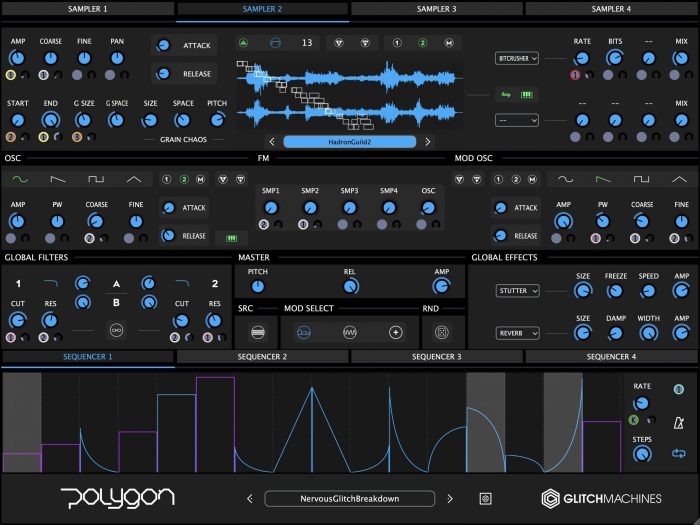

iZotope Trash
It’s important to note that this isn’t just another distortion tool. Trash 2 by iZotope, which was released in 2012, is still considered a benchmark in the world of complex distortion plug-ins. This one has a lot of interesting features and it appears to blend all of the stuff’s rough analog and nerdy digital subtleties into a tweaker’s delight.
Trash2 can do everything from mild tube saturation to over-the-top bit crushing and completely bizarre effects. This beast offers more than 60 distortion algorithms, 6 multi-effect modules, a breathtaking multiband waveshaper, and more than 100 presets.
Its sonic versatility for creative production with sophisticated filtering and
dynamics effects plus realistic speaker and space simulation leaves no wish unfulfilled. Trash2 is wonderful for giving lifeless sounds their own personality. You can dramatically transform any sound into something completely different. It’s an indispensable tool in my arsenal.
You can get your hands on a Distortion Plugin for a little money. It’s a lot more powerful than the one that came with your DAW. Trash2 is one of the best distortion plugins out there!
Kilohearts Multipass
KiloHearts Multipass is a multi-band effects processing package and one of the most elegant modular solutions I’ve seen in software of any sort.
It comes with a simplified workflow, a straightforward and great user interface, and a variety of “snap-in” effects, most of which can also be purchased individually.
Multipass can split your audio signal into up to five frequency bands, each with its own set of effects. It supports effects such as Delay, Compressor, Corus, Filter,
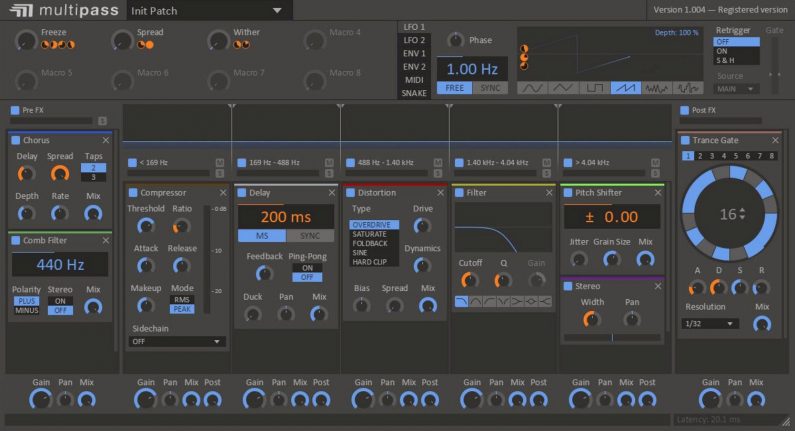
Limiter, Trance Gate, Bitcrush, Haas, Format Filter, Pitch Filter, Resonator, and many others, as well as the amazing sounding tools Disperser and Faturator. The only limiting factor is the number of snap-ins purchased.
You may mix everything together in a simple manner and create something entirely unique. With two LFOs, two envelope followers, and a pitch follower, Multipass has also great modulation options.
It’s fantastic to be able to place effect components anywhere you want in the signal route. The modulation arrangement transforms the surroundings into a very creative and dynamic processing environment. It’s a clever, intuitive concept with a lot of love for details. For example, I like the Duck function of the Delay Snapin. It would be great if you could still load third-party plugins. Even so, it’s an incredibly flexible multi-FX plug-in.
This was my personal list of the Best Sound Design VST Plugins, and I hope you enjoyed reading this. I will update this category regularly.








